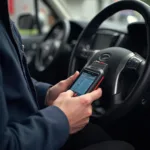The iconic BMW E30, produced between 1982 and 1994, holds a special place in the hearts of automotive enthusiasts. While not originally equipped with OBD2 ports, understanding how to access engine data on your E30 is essential for diagnostics and maintenance.
Navigating the World of Pre-OBD2 BMW E30s
Before diving into diagnostics, it’s important to understand that the BMW E30 predates the standardized OBD2 protocol introduced in 1996. This means you won’t find the familiar 16-pin OBD2 connector under the dashboard. Instead, E30s rely on a different diagnostic system.
Unlocking Your E30’s Secrets: Diagnostic Options
While your E30 might not have OBD2, it still offers ways to access engine data:
- BMW Round Connector: Early E30 models used a round 20-pin diagnostic connector located under the hood. This connector allows access to basic engine information.
- BMW 15-Pin Connector: Later E30s transitioned to a rectangular 15-pin connector, often found near the battery. This connector provides more comprehensive diagnostic capabilities.
 BMW E30 Diagnostic Connectors
BMW E30 Diagnostic Connectors
Choosing the Right Diagnostic Tool for Your E30
To retrieve and interpret diagnostic information from your E30, you’ll need a compatible diagnostic tool. Here are your options:
- BMW Specific Scan Tools: These tools are tailored for BMW vehicles and can communicate with both the round and 15-pin connectors. They offer in-depth diagnostic capabilities, including reading and clearing fault codes, monitoring live data, and performing specific tests.
- Adapters and Software: For those seeking a more budget-friendly approach, adapters are available to connect your E30’s diagnostic connector to a laptop or smartphone. Software specifically designed for BMW diagnostics is then used to interface with the vehicle.
Decoding Your E30’s Diagnostic Codes
Once you have the right tool, you can start reading diagnostic codes. Remember, these codes will be specific to BMW and might differ from standard OBD2 codes.
Tip: Online resources and forums dedicated to BMW E30s can be invaluable for understanding these codes and the potential issues they indicate.
Maintaining Your E30: Beyond Diagnostics
While accessing engine data is crucial, maintaining your E30 goes beyond just diagnostics. Regular servicing, using quality parts, and addressing issues promptly will ensure your E30 continues to provide miles of enjoyment.
Conclusion
Even without OBD2, keeping your BMW E30 running smoothly is achievable with the right knowledge and tools. Understanding your E30’s specific diagnostic system empowers you to tackle issues effectively and keep this classic on the road for years to come.

